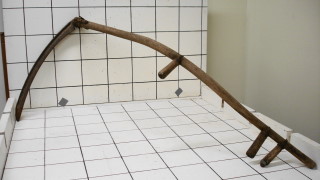The scythe has been around for centuries. Scythes are used as a tool for harvesting crops, such as wheat, or cutting away unwanted weeds, or tall grass. The scythe has a curved razor-sharp iron blade attached to the end of a wooden staff that has three handholds for easier control. This tool was widely used throughout Europe since before the Middle Ages, to the present, in countries like India, Nepal and the Americas. It is believed that the sickle was replaced by the scythe because of the scythe’s ability to quickly cut crops during the harvest season, which cuts the chances of losing valued crops due to the time it took to retrieve them with the sickle.
It was not uncommon for a woman to use this tool starting in the colonial period, however, back in the 1600s it was typically a “mans job” to cut the crop and bind the cut stalks together. The women would have followed close by collecting the banded work, therefore known as gatherers. Today you can find scythe competitions, with events testing who can cut an area of grass the fastest using a scythe. There are also events that test if a person with a scythe can be faster than modern-day machines, which often ends in favor of the scythe. These competitions are found primarily in southern states.
The scythe is often depicted as the tool of the Grim Reaper, also known as death, as seen in many artistic works depicting the plague. The plague has existed for centuries. Today, it can be treated with medicine, which did not exist back then. Two of the most well-known plagues were the Plague of Justinian of 542 C.E and the Black Death of 1348, both are credited with killing millions of people. There have been other outbreaks of illnesses throughout the world. For instance, malaria, yellow fever, and cholera struck North America hard in the 1800’s. People who were infected would sometimes flee to Texas, where the climate was hotter and more humid, in hopes of escaping the illness or to heal from it. Although the climate of Texas helped with some forms of sickness, it certainly was not without its epidemics. Migrants would spread the sickness that they were trying to escape to others of their new community. Therefore, malaria, yellow fever, and cholera were still very much a problem in Texas. However, tuberculosis was one of the most dangerous diseases in Texas during the 1800s and early 1900s, killing many.
The Grim Reaper, as we know him today in popular culture is often depicted standing close by his chosen victim until he chooses to take the person’s life, or he acts as a guide to lost souls and show them the way to heaven or hell. In video games, Death normally acts as one of the many adversaries a gamer needs to defeat to move onto the next level. Death is also associated with biker gangs and military unit mascots. In the past Death would even find its way to be immortalized as statues in cathedrals. Death has always held a special place in man’s mind because of fear and respect of mortality; the inevitable end.
